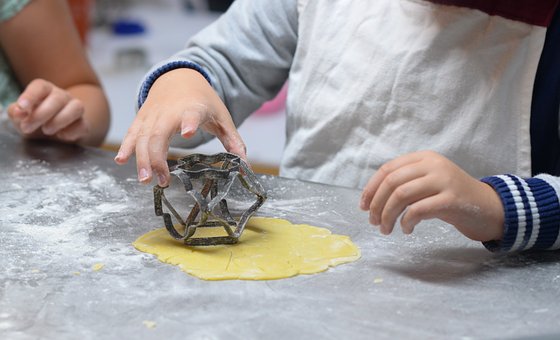
This article is republished from The Conversation under a Creative Commons licence. It was picked up by the National Post on Dec. 17.
When we think about the holidays we often think about all of the great food that we will get to enjoy — your father’s famous stuffing or your grandma’s homemade cookies. Food brings us together, reminds us of loved ones and represents tradition.
For the little ones in our lives, the holidays are exciting. And it can be tricky to find ways to harness this energy while checking off your own holiday to-do list. Getting your kids in the kitchen is a great way to entertain them during the holidays. It also helps build those family traditions and special memories.
Research also suggests cooking can help your child establish healthy habits. As nutrition researchers and dietitians, we can offer you many good reasons for engaging kids in the kitchen.
Combat picky eating, reduce waste
Strategies to get your children to eat such as asking your child to eat “three more bites” have been shown to be counterproductive in encouraging healthier food choices.
Instead, take a more relaxed approach to mealtimes by getting your child involved before the meal hits the table. Kids who are involved in preparing a meal have more positive attitudes towards food and are more interested in trying the foods they make, even when the menu includes new foods and vegetables.
Food waste has become a billion dollar problem in Canada and household-level waste is a huge contributor. We throw out food for all sorts of reasons. But research suggests that homes with children waste more food. The unpredictable eating patterns and preferences of little family members can be challenging to plan for. But, research at the University of Guelph found that families who involve their children in food preparation waste less food.
And it might be this simple: getting your child in the kitchen increases the likelihood of them eating the food that is served, meaning less ends up in the garbage and you save more on your next grocery bill.
To get you started, we’ve picked out our favourite kid-friendly cookbooks:
The Little Cookery
By Lottie & Eli Aldarwish (2017, Little Cookery)
Age 2+
Why we love it: The cookbook was co-created with the author’s son Eli, so the recipes are guaranteed child-friendly. Graphic recipes make it easy for kids as young as two to get into the kitchen.
Recipes also include ingredient substitutions for children with allergies.
Cook By Colours
By Brent Currie & Jessie Jarden (2015, Cook By Colours Inc.)
Age 2+
Why we love it: Graphic recipes and colour-coded measuring cups make it easy for little ones.
Each recipe includes additional steps that teach important kitchen lessons like washing the dishes afterwards!
Age 6+
National Geographic Kids Cookbook
By Barton Seaver (2014, National Geographic Children’s Books)
Age 6+
Why we love it: This is more than a cookbook. In addition to delicious recipes, side bars include fun facts on real people and food from around the world as well as food-focused challenges.
Recipes also teach other food skills like how to plant a kitchen garden and pack the ultimate school lunch.
The Cookbook for Kids
By Williams Sonoma (2011, Weldon Owen)
Age 6+
Why we love it: This cookbook includes over 60 yummy, child-friendly recipes. The colourful illustrations and fun facts keep cooking fun for children.
The book also touches on the importance of healthy eating, a great addition to your cooking conversations.
What Shall We Cook Today
By Peters & Smal Ryland (2015, Ryland Peters & Small)
Age 6+
Why we love it: This cookbook includes 70 recipes and is divided into seasons which can help you use local ingredients!
As part of our research with the Guelph Family Health Study, we have also created four free family-friendly cookbooks of our own.
Cooking is language, math and science
Cooking or baking together is also a great way to go screen-free for a couple hours, listen to holiday music and enjoy each other’s company.
Choose what works for your family — “make your own pizzas” on Fridays, a weekend brunch or afternoon cookie decorating — and have fun. The memories you create while cooking with your children will last long after the holidays are over. And the bigger the mess, the better the story later on!Picking out a recipe and preparing it gives everyone “together” time to look forward to. Cooking together also gives everyone in the family a role and increases positive conversation, both of which are key to increasing family cohesion and child well-being. Check out these ideas for age-appropriate kitchen tasks.
Cooking with your child is also a great opportunity to teach language, science and even math. Reading recipes enhances vocabulary. Cooking and baking involve measurement, which is a perfect opportunity to introduce addition and subtraction. Slicing your personal pizza is a great way to explain fractions to your child (who said math can’t be fun?).
Cooking and baking are rooted in science so the experience can be a science experiment in itself.
This year, give the little ones in your life the gift of cooking, it’s a gift that will last a lifetime.![]()